There are different Famous Monuments of World. The term ‘monument’ is usually applied to buildings or structures that are considered examples of important architectural and/or cultural heritage.
Monuments have been created for thousands of years, and they are often the most durable and famous symbols of ancient civilizations.
Other than the individual government that protecting the monuments in their jurisdiction, there are institutions such as UNESCO‘s World Heritage Site programme and World Monuments Fund, that protect and preserve monuments that considered to possess special natural or cultural significance for the world.
The world is adorned with a myriad of iconic monuments that stand as testaments to human ingenuity, culture, history, and artistic expression. From ancient wonders to modern marvels, these famous monuments captivate the imagination and draw millions of visitors from around the globe.
Some of the important Famous Monuments of World:
The Great Wall of China, China:
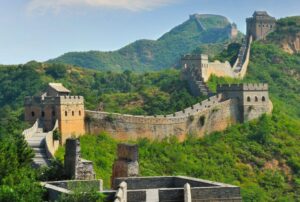
the-great-wall-of-china
Build Reason: The Great Wall was built to protect China’s northern borders from wandering groups like the Mongols and the Xiongnu. It’s almost 13,000 miles long. The physical and mental barriers of the wall kept foreign armies from invading Chinese states and empires.
Walls and other defenses were first built in northern China in the 7th century BC, during the time of the Warring States. But the most well-known parts of the Great Wall were built from the 14th to the 17th centuries, during the Ming Dynasty (1368–1644). The building of the Great Wall began in many places and times, but the Ming Dynasty is credited with making the most famous parts of it.
Taj Mahal, India:
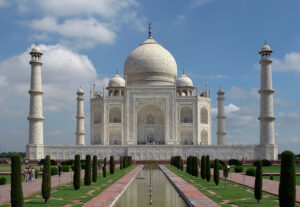
Taj_Mahal,_Agra
Build Reason: Shah Jahan built the Taj Mahal as a tomb for Mumtaz Mahal, his favorite wife. When Mumtaz Mahal died while giving birth in 1631, Shah Jahan built her a beautiful tomb. A masterpiece of Mughal building, the Taj Mahal stands for love that will last forever.
The Taj Mahal was built starting in 1632, one year after Mumtaz Mahal died. After the main tomb was finished in 1643, it took several years to finish the complex, which included the grounds and other buildings. In 1653, the Taj Mahal was mostly done. The Taj Mahal is a world-famous structure known for its high level of craftsmanship, use of white marble, and symmetrical shape.
Pyramids of Giza, Egypt:
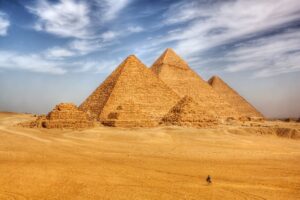
pyramid
Build Reason: The Pyramids of Giza were built as huge tombs for Egyptian pharaohs to make sure they would have a safe journey after death. Along with graves, this structure had temples, causeways, and smaller pyramids for queens and other members of the royal family.
In the Fourth Dynasty of the Old Kingdom, work on the Pyramids of Giza began. The three big pyramids on the Giza Plateau were built very quickly. The Great Pyramid of Khufu was built first, around 2580 BC. After that came the Pyramids of Khafre and Menkaure. Scholars don’t agree on when and how the pyramids were built, but they were finished around the 26th century BC.
Eiffel Tower, France:

eiffel
Build Reason: it was built to honor the 100th anniversary of the French Revolution, the Eiffel Tower was built as the main arch for the Exposition Universelle in Paris in 1889. The tower was meant to show how strong France’s economy was and how far it had come in technology. Gustave Eiffel, a French builder, built the tower. It got mixed reviews at first, but over time it became a symbol of Paris.
Year Built: The Eiffel Tower was built for the World’s Fair, from January 1887 to March 1889. Artists and smart people at the time were against the makeshift tower’s unusual design. People were amazed by its unique form and high-quality engineering, which made it stand out. The Eiffel Tower, one of the most famous buildings in the world, stands for French culture and engineering.
Machu Picchu, Peru:
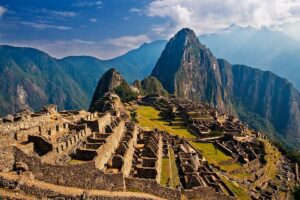
Machu_Picchu,_Peru
Build Reason: Scholars disagree whether Machu Picchu was built as a royal estate or religious retreat for Inca ruler Pachacuti. Machu Picchu was an Inca ceremonial and administrative center built in the mid-15th century. It may have been a royal estate or spiritual retreat with religious, astrological, and agricultural significance.
It is believed that Machu Picchu was built around 1450 AD. Inca monarch Pachacuti built it, and it was presumably used for decades until being abandoned, probably due to the Spanish Conquest in the 16th century. Machu Picchu’s architectural and engineering marvels and gorgeous mountainous environment have made it one of the world’s most famous and well-preserved ancient sites despite its short tenure.
Colosseum, Italy:
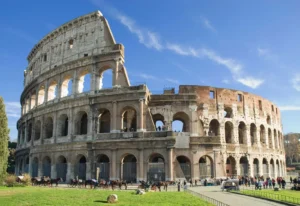
Colosseum-Rome-Italy
Build Reason: Vespasian of the Flavian dynasty ordered the construction of the Colosseum. Emperor Titus, Vespasian’s son, ordered construction. Colosseum was designed for gladiator competitions, animal hunts, executions, and other public events. It entertained and calmed Romans by symbolizing their strength and grandeur.
Emperor Vespasian began building the Colosseum in AD 72 and Emperor Titus finished it in AD 80. The 100-day inaugural games celebrated the Colosseum’s completion and drew thousands of spectators. One of ancient Rome’s most famous emblems, the Colosseum demonstrated Roman engineering and architecture.
Statue of Liberty, USA:

Statue of Liberty
Build Reason: The Statue of Liberty, officially “Liberty Enlightening the World,” was a gift from France to US. It symbolized the two nations’ bond of friendship and shared values of liberty and democracy. French sculptor Frédéric Auguste Bartholdi created and built the statue, while Gustave Eiffel constructed its interior. Since its October 28, 1886 dedication, the statue has symbolized freedom and democracy worldwide.
French builders began building the Statue of Liberty in 1875. After finishing the statue’s copper framework in 1884, the components were transferred to the US. American architect Richard Morris Hunt created Liberty Island’s pedestal to support the monument. President Grover Cleveland dedicated the statue on October 28, 1886, after its final assembly in New York.
Christ the Redeemer, Brazil:
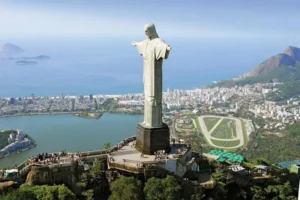
Christ the Redeemer
Build Reason: Christ the Redeemer symbolizes Brazilian Christianity and peace. The statue was conceived in the 1920s to emphasize Brazil’s Catholic identity. To erect a religious monument that would overlook the city and protect it also impacted the idea.
Christ the Redeemer was built from 1926 to 1931. The statue was designed by Brazilian engineer Heitor da Silva Costa and French sculptor Paul Landowski. The monument on Rio de Janeiro’s Corcovado mountain has become one of Brazil’s most famous attractions, drawing millions of visitors annually. The statue’s outstretched arms symbolize Christ’s embrace of humanity and are a major religious and cultural emblem for Brazil.
Angkor Wat, Cambodia:
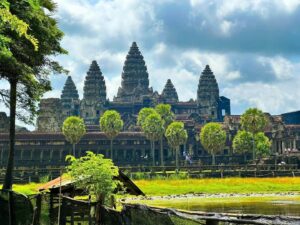
Angkor_Wat_Temple
Build Reason: Angkor Wat was built in the early 12th century as a Hindu Vishnu temple. It was the state temple of the Khmer civilization, a great Hindu-Buddhist civilization that governed Southeast Asia. After being transformed, Angkor Wat became a Buddhist temple. Its architectural beauty and spiritual significance reflect Khmer culture and religion.
Angkor Wat was built in the early 12th century under King Suryavarman II. It is thought to have begun around 1113 AD in the early 12th century. Angkor Wat became the capitol of the Khmer Empire after decades of construction. Angkor Wat is one of the world’s most important archaeological sites and religious structures due to its detailed bas-reliefs, spectacular architecture, and wide moat.
Petra, Jordan:
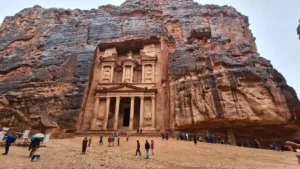
Petra
Build Reason: Petra was the Nabataean Kingdom’s capital and an important trading hub at the intersection of historic trade routes. A strategic location and control over trade routes made the city prosperous. The Nabataeans’ water engineering skills developed a complex system of dams, cisterns, and conduits to supply the city with water. The Nabataeans’ rock-cut temples, tombs, and constructions at Petra demonstrate their architectural and engineering skills.
Petra’s building is said to have begun in the 4th century BC. Petra peaked between the 2nd century BC and 2nd century AD during the Hellenistic and Roman periods. The Nabataeans prospered through trade and resource management since the city was strategically located along trade routes. After the Roman occupation, Petra declined, but its rock-cut architecture and archaeological value made it a UNESCO World Heritage Site and famous tourist destination.
Complete List of Famous Monuments Of World:
| Name of the Monument | Country |
| Statue of Liberty | New York, USA |
| The Eiffel Tower | Paris, France |
| St Basil’s Cathedral | Moscow, Russia |
| Blue Domed Church | Santorini, Greece |
| The Great Sphinx | Giza, Egypt |
| Machu Pichu | Peru |
| Big Ben | London |
| Burjal Arab Hotel | Dubai |
| Tower of Pisa | Italy |
| Christ the Redeemer | Riode Janeiro, Brazil |
| Lascaux Cave Paintings | France |
| Loch Ness | Scotland |
| Mont St Michel | France |
| Bran Castle | Transylvania, Romania |
| Agia Sophia | Istanbul, Turkey |
| Brandenburg Gate | Berlin, Germany |
| Acropolis | Athens, Greece |
| Sagrada Familia | Barcelona, Spain |
| Uluru Sandstone | Australia |
| Mount Fuji | Japan |
| Mount Eden Crater | New Zealand |
| Al Aqsa Mosque | Jerusalem |
| Angkor Wat | Cambodia |
| St Peter’s Cathedral | Vatican City |
| Mount Rushmore | South Dakota |
| Victoria Falls | Between Zambia and Zimbabwe |
| The Great Canyon | Arizona |
| Petra Rock-cut Architecture | Jordan |
| Cape of Good Hope | SouthAfrica |
| Chichen Itza | Mexico |
| Inukshuk | Canada |
| Table Mountain | Cape Town, South Africa |
| Golden Gate Bridge | San Francisco, California |
| Kilimanjaro | Tanzania |
| Forbidden City | Beijing |
| Iguazu Falls | On the border of Brazil and Argentina |
| The Colosseum | Rome, Italy |
| Twyfelfontein–Ancient Rock Engravings | Namibia |
| The Blue Mosque | Istanbul |
| Millau Bridge | France |
| Luxor Temple | Egypt |
| Faisal Mosque | Islamabad, Pakistan |
| The Empire State Building | New York |
| Newgrange Tomb | Ireland |
| TilchoLake | Nepal |
| Pompeii | Italy |
| The Wailing Wall | Jerusalem |
| Abu Simbel | Egypt |
| Middle of the Earth or
The Ciudad Mitaddel Mundo |
Ecuador |
| Potala Palace | Lhasa, Tibet |
| Angel Falls | Venezuela |
| Ephesus | Turkey |
| Twelve Apostles | Australia |
| The National Chiang Kai-shek Memorial Hall | China |
| The Sultan Ahmed Mosque | Turkey |
Amazing Facts You Should Know
- The Twelve Apostles is a collection of limestone stacks off the shore of the Port Campbell National Park, by the Great Ocean Road in Victoria, Australia. Their proximity to one another has made the site a popular tourist attraction. Currently there are eight apostles left, the ninth stack having collapsed dramatically in July 2005.
- The Potala Palace in Lhasa, Tibet Autonomous Region was the residence of the Dalai Lama until the 14th Dalai Lama fled to India during the 1959 Tibetan uprising. The palace is named after Mount Potalaka, the mythical abode of the bodhisattva Avalokiteśvara.
- The Colosseum is an oval amphitheatre in the centre of the city of Rome, Italy. Built of concrete and sand, it is the largest amphitheatre ever built.
- The Acropolis is located on a flat-topped rock that rises 150 m (490 ft) above sea level in the city of Athens, with a surface area of about 3 hectares (7.4 acres). It was also known as Cecropia, after the legendary serpent-man, Cecrops, the first Athenian king.
- The Taj Mahal’s marble changes color depending on the time of day. It appears pink in the morning, white during the day, and golden in the moonlight.
- Angkor Wat is the largest religious monument in the world and was originally built as a Hindu temple before gradually transitioning into a Buddhist temple complex.
Also, Read











